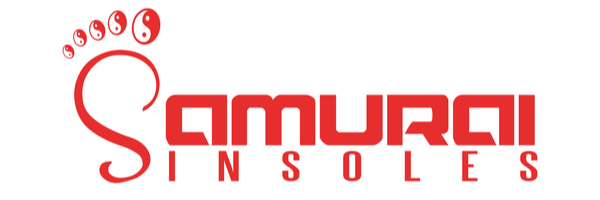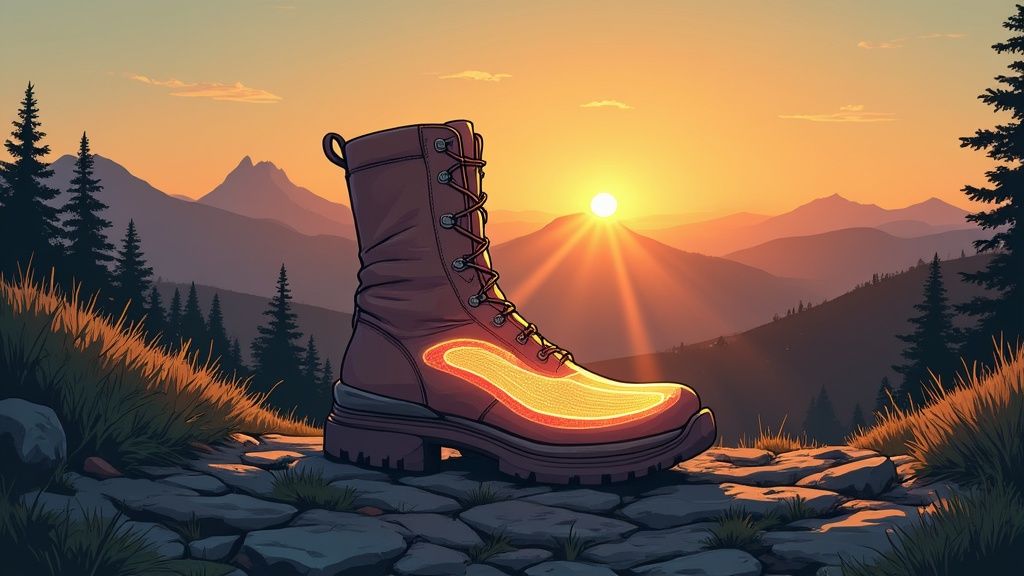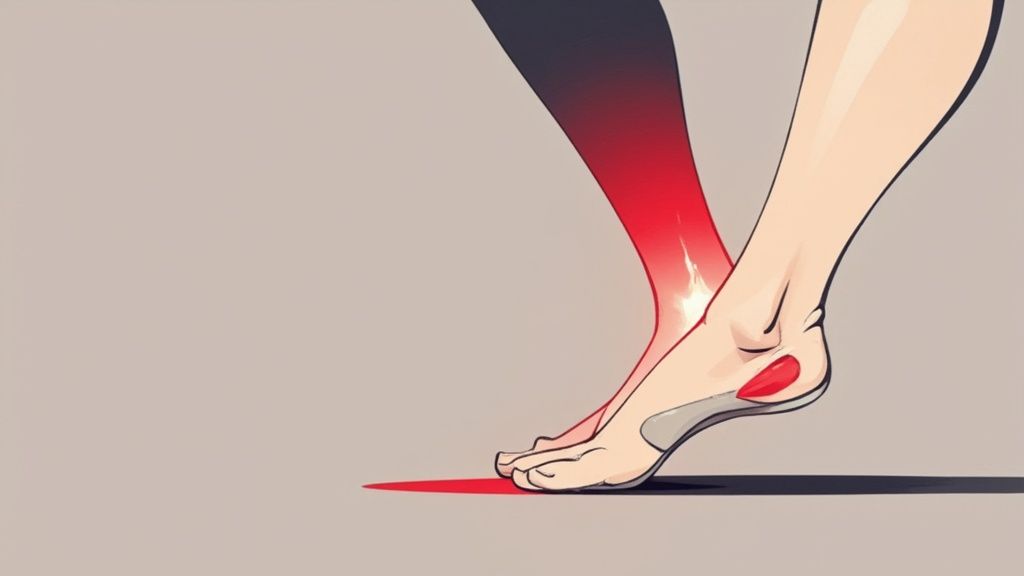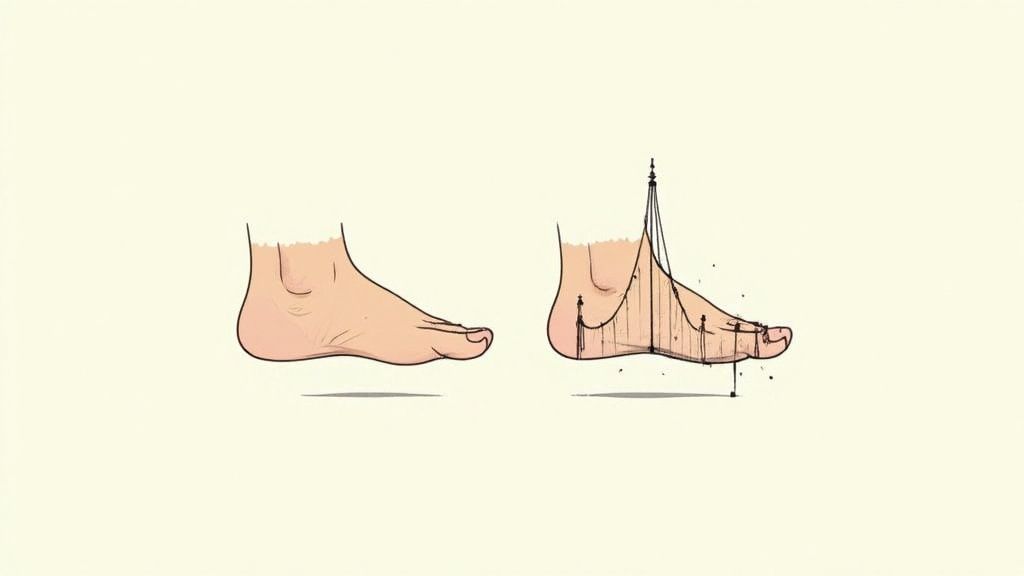So, what exactly is overpronation of the foot? Simply put, it's when your foot rolls too far inward with each step you take. A little bit of inward roll is perfectly normal—it’s how your body absorbs shock. But when that roll becomes excessive, it can throw your whole body out of alignment.
Decoding Your Foot's Natural Motion
Think of your foot's arch as the built-in suspension system for your body. When you walk or run, your foot is supposed to roll slightly inward. This natural movement, called pronation, helps spread the force of impact from the ground evenly through your foot and up your leg. It’s a brilliant piece of biological engineering.
The problem arises when this system gets out of whack. With overpronation, the arch flattens out more than it should, causing that excessive inward roll. This is a very common issue, and it's important to understand it’s about the motion of your foot, not just its shape. People often confuse it with having flat feet, but while they can be related, overpronation is about what happens when you’re on the move.
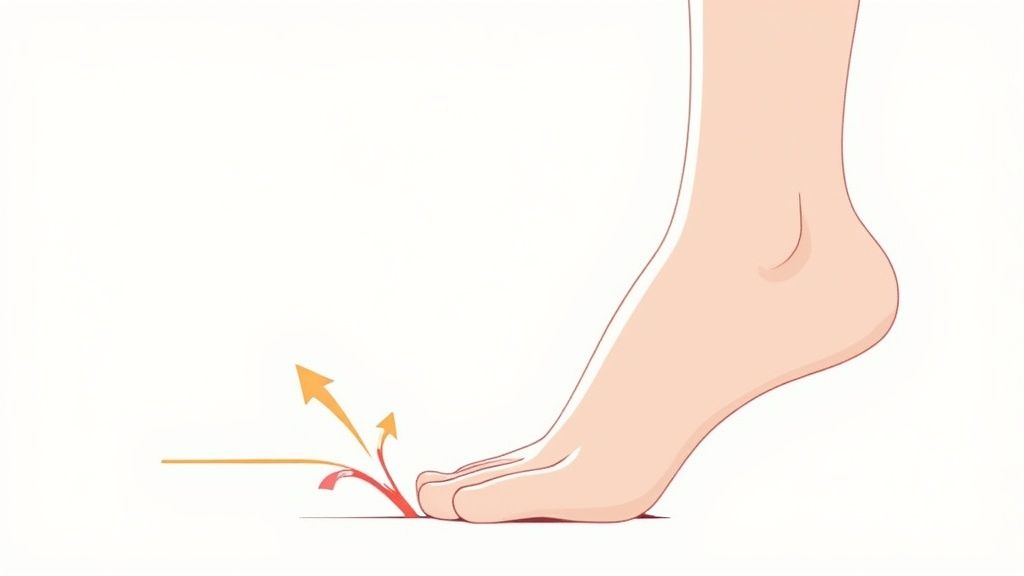
The Three Types of Foot Pronation
To get a better handle on your own foot health, it helps to know which of the three main gait patterns you have. Most people's feet fall into one of these categories:
- Neutral Pronation: This is the ideal. Your foot lands on the outside of the heel and then rolls inward just the right amount—about 15 percent—to absorb shock and efficiently support your body weight.
- Overpronation: Here, your foot keeps rolling inward past that ideal 15 percent. This causes your arch to flatten and puts extra strain on your foot, ankle, and even your big toe as it pushes off.
- Supination (Underpronation): This is the opposite scenario. Your foot lands on the outer edge but doesn’t roll inward enough. This means most of the impact stays concentrated on the outside of your foot and smaller toes.
Key Takeaway: Overpronation is far from rare. A 2017 study revealed that roughly 13.6% of young adults showed signs of flatfoot, which is often tied directly to overpronation. This highlights just how common these biomechanical challenges are. For a deeper dive, you can read the complete study on foot pronation prevalence.
Figuring out which group you belong to is the first step toward getting the right support and feeling better. This simple table breaks down the key differences to help you see where you might fit.
Gait Pattern Comparison at a Glance
| Feature | Neutral Pronation (Normal) | Overpronation (Rolling Inward) | Supination (Rolling Outward) |
|---|---|---|---|
| Foot Roll Direction | A slight, controlled inward roll. | An excessive, deep inward roll. | Stays on the outer edge with minimal roll. |
| Arch Movement | Flexes naturally to absorb shock. | Collapses and flattens under pressure. | Stays rigid with poor shock absorption. |
| Shoe Wear Pattern | Even wear centered on the ball and heel. | Extra wear on the inside edge and near the big toe. | Extra wear on the entire outer edge of the shoe. |
Looking at the bottom of an old pair of shoes is often the easiest way to spot your pattern. The wear and tear doesn't lie! Once you know your gait, you can take steps to correct imbalances and prevent pain.
The Hidden Causes of Overpronation
So, what’s really behind overpronation? It’s rarely just one thing. Think of it like a car's wheel alignment—sometimes it’s off right from the factory, and other times it gets knocked out of whack after hitting a few too many potholes. Your feet are pretty similar.
For many people, the tendency to overpronate is simply in their DNA. You might have been born with a certain foot structure, like naturally low arches, often called flat feet. This anatomical setup means your foot's natural suspension system doesn't have the support it needs to stop the arch from collapsing inward under your body weight.
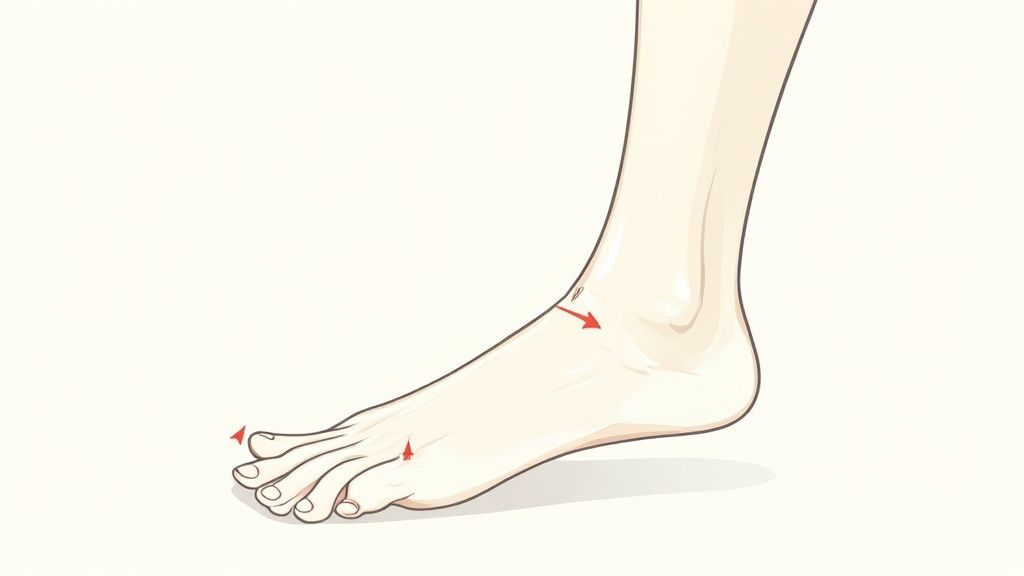
How Lifestyle Weakens Your Arch
But what if you weren't born with flat feet? Life happens. Certain activities and even major life events can weaken the muscles and tendons holding up your arches, leading to what’s known as acquired overpronation. Over time, all that stress adds up and your foot’s alignment can start to break down.
Some of the most common lifestyle factors include:
- High-Impact Activities: The constant pounding from sports like running or basketball, especially on hard surfaces, can wear down your arch support over the years.
- Prolonged Standing: If your job keeps you on your feet all day, you're putting constant, low-grade strain on the ligaments and muscles in your feet.
- Pregnancy: Hormonal shifts can cause ligaments to relax and loosen throughout the body, including in your feet. Combine that with the extra weight, and you have a perfect recipe for added pressure on the arches.
Excess body weight is another huge factor, as it dramatically increases the load your feet have to bear with every step. This constant pressure can stretch out the posterior tibial tendon—the primary support structure for your arch—causing it to weaken and eventually flatten.
Research has repeatedly shown a strong connection between a higher body mass index (BMI) and overpronation. A 2023 study, for example, found that most people with highly pronated feet were also overweight. This suggests that the extra force is a major contributor to the condition. You can dig into the research linking BMI and foot posture for a deeper look.
Getting to the bottom of these causes is the first step toward finding relief. Whether your overpronation is due to genetics, lifestyle, or a bit of both, understanding the why helps you find the most effective way to get your feet back in balance and finally ditch the pain.
Identifying the Telltale Signs of Overpronation
Your body has its own way of telling you when something’s not quite right with your mechanics. Long before you feel any serious pain, your feet—and even your favorite pair of shoes—are probably dropping hints. Learning to recognize these clues is the first step to understanding what's going on.
One of the easiest ways to check is to look at the soles of your shoes. Grab a pair you've worn a lot and flip them over. Do you see extra wear on the inside edge? If the area under the ball of your foot and the inner heel is worn down much more than the outside, that’s a classic sign of overpronation. This wear pattern is a perfect map of how your foot is rolling inward with each step.
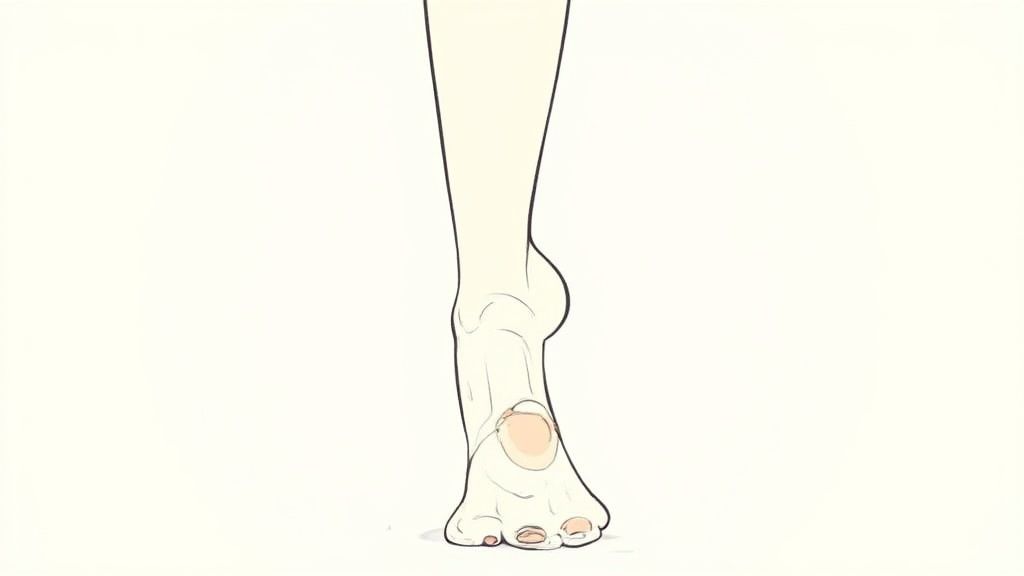
From Your Feet All the Way Up
Your shoes aren't the only things talking. Your body is likely sending signals, too. A little foot fatigue is one thing, but overpronation creates a specific kind of strain that leads to some very recognizable problems.
Keep an eye out for these common physical symptoms:
- Heel or Arch Pain: If you feel a sharp, stabbing pain in your heel or through your arch—especially with those first few steps in the morning—that's a telltale sign of plantar fasciitis. Overpronation is a major cause of this condition.
- Bunions and Hammertoes: When your foot collapses inward, it forces your big toe into an unnatural position. Over time, this can lead to painful bunions or cause the smaller toes to curl up, a condition known as hammertoes.
- Shin Splints: The muscles in your lower leg have to work much harder to keep you stable when your foot overpronates. This extra work often leads to that familiar, nagging pain along your shin bone.
- Knee, Hip, or Back Pain: The problem doesn't stop at your ankles. Think of your body as a chain. A faulty foundation in your feet can throw your entire alignment out of whack, causing aches and pains in your knees, hips, and even your lower back.
A Quick At-Home Check: Try the "wet test." Get the bottoms of your feet wet, then step onto a piece of cardboard or a dry patch of pavement. If you see a footprint that shows almost the entire sole of your foot with very little curve in the middle, you probably have flat feet and a tendency to overpronate.
Spotting these signs is your first move toward getting comfortable again. While you can't magically change your foot structure, you absolutely can manage how it functions. Along with the right insoles, you can also try specific foot pronation exercises to build up the muscles that support your arch and improve your overall stability.
How Overpronation Impacts Your Entire Body
Think of your feet as the foundation of a house. When that foundation is solid and balanced, the whole structure above it stands strong. But what happens if the foundation is crooked? That’s what overpronation does—it creates an unstable base, sending a ripple effect of misalignment all the way up your body.
This chain reaction begins the second your foot hits the ground. The excessive inward roll of your foot forces your ankle to turn inward, too. To make up for it, your lower leg bone (the tibia) has to rotate internally, putting a subtle but constant twisting pressure on your knee. This is often the hidden culprit behind that nagging knee pain that just won't go away.

The Kinetic Chain Reaction
The problems don't stop at your knees. To keep you from falling over, your hips have to adjust for that inward rotation happening below, often tilting forward as a result. This can lead to significant strain on your hip joint and the muscles around it. It's a major reason why some people experience hip pain when running, even if their running form seems fine otherwise.
From there, this cascade of compensations travels right up to your lower back and spine, which have to curve and shift just to keep your head level. It’s amazing, but that chronic lower back soreness you feel could actually be traced all the way back to how your feet move.
You might be surprised to learn just how common this is. Studies have found that overpronation affects up to 21.0% of females and 16.8% of males. These numbers show just how many people are walking around with this imbalance, often without realizing it's the root cause of their aches and pains.
So, that persistent pain in your knees, hips, or back might not be an isolated issue. It could be a direct result of how your feet meet the ground with every step you take. Understanding this connection is the first step toward feeling better.
Ready to learn what you can do about it? Check out our complete guide on how to fix overpronation and bring your body back into balance.
How the Right Insoles Can Bring Your Body Back into Balance
So, we've talked about how overpronation can knock your whole body out of whack. The good news is that there’s a straightforward and incredibly effective way to fight back: supportive insoles. They work by giving your feet the external support they're missing, gently guiding them back toward a natural, healthier alignment with every step.
Think of a quality insole as a custom-built cradle for your foot. Instead of allowing your arch to collapse and your ankle to roll inward, it provides a stable foundation that stops that excessive motion in its tracks. It’s not about forcing your foot into an uncomfortable position; it's about preventing the unhealthy movement that causes all that pain.
What to Look for in an Insole
The real magic happens when two specific features work in harmony.
- A firm, supportive arch acts like a brace, keeping your arch from flattening out under your body weight.
- A deep heel cup cradles your heel, stopping it from rolling too far inward when you land.
The goal is to build stability from the ground up. By controlling the heel and supporting the arch, insoles realign the foot. This simple correction can immediately reduce stress on your plantar fascia, shins, knees, and even your lower back, addressing pain at its source.
When your foot is properly aligned, your entire kinetic chain—from your ankles all the way up to your spine—can finally work the way it's supposed to.
If you want to dive deeper into how to improve your foot mechanics, our guide on the best insoles for overpronation has more detailed insights. These specially designed supports can bring your body back into balance, offering relief you can feel all day long.
Answering Your Top Questions About Overpronation
As you dig into the world of overpronation, it's natural to have a few questions pop up. Getting clear answers is the first step toward not just understanding the problem, but actually doing something about it. Here are some straightforward answers to the questions we hear all the time.
Can Overpronation Be Cured for Good?
This is the big one, and it's an important question. Since overpronation is usually tied to the way your body is built—your biomechanics—it’s better to think of it as something you manage and correct, rather than "cure." For most people, especially if you have flat feet from birth, managing the condition will be a long-term commitment.
The real goal is to get that excessive inward roll under control so you can stop the pain and avoid future injuries. This is where tools like supportive shoes, quality orthotic insoles, and targeted exercises truly shine. They don't magically rebuild your arch, but they do something just as good: they help your foot function correctly when you move, which brings lasting relief and stability.
Key Insight: Think of it this way: effective management means you don't have to put up with the pain. By consistently using support like insoles, you're giving your feet the daily guidance they need to work properly. In day-to-day life, that can feel just like a cure.
Are Flat Feet and Overpronation the Same Thing?
It's easy to get these two mixed up because they're so closely related, but they aren't exactly the same. Knowing the difference is key to finding the right solution.
- Flat feet is about anatomy. It simply means you have a low or collapsed arch when you're just standing still. It's a description of your foot's static structure.
- Overpronation is about motion. It describes the action of your foot rolling too far inward when you're moving—like when you walk, jog, or run.
While it's possible to have a decent-looking arch and still overpronate during activity, it's far more common the other way around. If you have significant flat feet, you almost certainly overpronate, because there’s no arch structure there to stop your foot from collapsing inward under your body weight.
What Exercises Can Help With Overpronation?
Absolutely! Strengthening the muscles that support your arches and keep your ankles stable can make a world of difference. When you pair these exercises with a good pair of supportive insoles, you create a powerful one-two punch for managing overpronation.
Here are three simple yet effective exercises you can try:
- Short Foot Exercise: Sit down with your feet flat on the floor. Without curling your toes, try to pull the ball of your foot back toward your heel. You should feel your arch lift up, creating a small "dome." Hold for a few seconds and release.
- Calf Raises: Stand up straight and slowly raise your heels off the ground, pushing through the balls of your feet. This builds strength in your calves and Achilles tendon, which are critical for good foot mechanics.
- Towel Curls: Lay a small towel on the floor in front of you. Using only your toes, scrunch and pull the towel toward you. This is a fantastic way to work the tiny, deep muscles inside your feet.
When Is It Time to See a Doctor for Foot Pain?
While insoles and exercises bring relief to a lot of people, there are times when you need to call in a professional. You should definitely see a doctor or a podiatrist if your pain is severe, getting worse, or just not improving with these at-home strategies.
A professional can give you a firm diagnosis and make sure nothing else is going on. They can also create a more personalized treatment plan, which might include things like physical therapy or even custom-molded orthotics if your situation is more complex.
Now that you have the answers to these common questions, you're in a much better position to take charge of your foot health. Samurai Insoles were designed from the ground up to fight the effects of overpronation by delivering the stability and support your feet are crying out for. Discover the right insoles for you and start your journey toward pain-free movement today.
